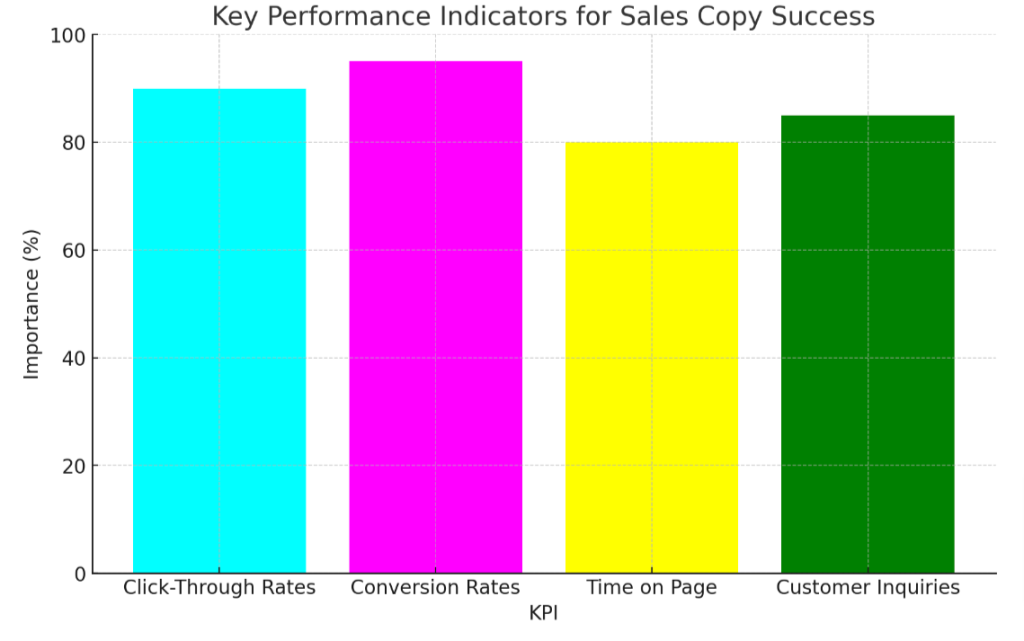Evaluating Your Sales Copy: Strategies for Measuring and Enhancing Impact
Do your sales pages seem to be falling short of expectations? Studies show that compelling copywriting can increase conversion rates by up to 30%. The focus of this article is to guide you through the process of measuring and improving the success of your sales copy.
Get ready for an exciting journey into optimizing your content for optimal results!
Key Takeaways
- Compelling copywriting can boost conversion rates by up to 30%.
- Measuring copywriting effectiveness helps identify areas for improvement and ensures alignment with market trends and customer preferences.
- Setting clear goals, choosing relevant metrics, and using tools like Google Analytics and A/B testing are key in measuring the success of sales copy.
- By continuously evaluating and analyzing sales copy performance, you can refine your writing skills to achieve better results in driving sales and achieving marketing goals.
Understanding the Importance of Measuring Copywriting Effectiveness
Copywriting serves as a powerful tool in the world of business. Companies harness its potential to steer consumer behavior, drive web traffic, and enhance brand recognition. However, like any other marketing strategy, it demands rigorous evaluation for sustained success.
This is where the significance of measuring copywriting effectiveness emerges.
Understanding if your sales page resonates with your target audience hinges on assessing copywriting effectiveness. Such analysis garners critical insights into how well your message engages readers and prompts conversions.
It helps identify weak points that require optimization while highlighting strong areas contributing to goals such as views or conversion rates. Thus, by regularly gauging the impact of your sales copy, you improve not only its converting power but also ensure that it consistently aligns with changing market trends and customer preferences.

Setting Goals and Choosing Metrics for Measure
Success in copywriting hinges on setting clear goals and choosing the right metrics. Here’s your roadmap:
- Define what success looks like for your sales copy. It could be increased traffic, higher conversion rates, or more customer inquiries.
- Identify key performance indicators (KPIs). These KPIs could include click – through rates, conversion rates, or time spent on page.
- Set attainable goals based on your KPIs. Start small and gradually raise the bar as you improve.
- Choose the right metrics to measure success. Some useful metrics might be views, clicks, purchases, or shares of your sales copy.
- Use a tracking tool to monitor these metrics regularly.
- Make necessary adjustments based on data derived from these measurements.
- Implement changes in the copywriting process to enhance efficiency and effectiveness.
- Stay consistent with measurement practices over time for accurate results.
Tools and Techniques for Measuring Copywriting Success
Evaluating the effectiveness of your sales copy can be straightforward using the right tools and techniques.
- Use Google Analytics as a critical tool to track visitors to your sales page, measure conversion rate, and quantify the impact of copywriting.
- Set up A/B testing scenarios to compare different versions of a sales copy. This tool will help identify which version is more effective in converting power.
- Implement heat maps on your website to visualize where users click and how long they stay on a particular section.
- Utilize customer surveys and feedback forms to unearth qualitative insights about what works and what doesn’t in your copywriting.
- Use CRM software or tools like HubSpot to follow the customer journey and see how often your copy converts leads into customers.
- Look at social media analytics for shares, comments, likes, retweets; they serve as effective copy measurement techniques.
- Keep an eye on SEO ranking for specific keywords in your content; this is another way of judging the effectiveness of the copywriting.
- Use email marketing metrics like open rates and click-through rates to measure how well certain phrases or calls-to-action are performing.
- Fix goals in Google Ads or Facebook Ads manager for tracking ad response rate – another gauge of measuring the achievement of your sales copy.
Continuously Improving Your Copywriting Performance
To continuously improve your copywriting performance, it is essential to regularly evaluate and analyze your sales copy. Look for areas where you can make improvements and optimize the effectiveness of your written content.
This includes assessing the impact of your copy on conversion rates, tracking visitor behavior on your sales page, and evaluating how well your copy is able to persuade and convert readers into customers.
By consistently measuring the success of your sales copy using key performance indicators and effective measurement techniques, you can refine and enhance your writing skills to achieve better results in driving sales and achieving marketing goals.

Conclusion
In conclusion, measuring the success of your sales copy is crucial for improving its effectiveness and achieving your goals. By setting clear goals, choosing relevant metrics, and utilizing tools and techniques to track performance, you can continuously optimize your copywriting efforts.
Remember to evaluate conversion rates, views analytics, and the impact on visitors and sales pages in order to gauge the efficiency of your sales copy. Keep refining and quantifying the results to ensure ongoing success.

